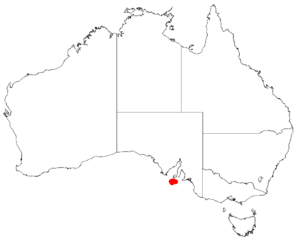Enigma hakea facts for kids
Quick facts for kids Enigma hakea |
|
|---|---|
| Scientific classification | |
| Genus: |
Hakea
|
| Species: |
aenigma
|
 |
|
| Occurrence data from Australasian Virtual Herbarium | |
The Hakea aenigma, also known as the enigma hakea, is a special kind of shrub. It belongs to the Proteaceae plant family and grows naturally in South Australia. This plant is quite unique because it's one of only two Hakea species that can only reproduce by sending out new shoots from its roots. This means it doesn't make seeds!
Contents
What is the Enigma Hakea Like?
The enigma hakea is a round, bushy shrub. It usually grows to be about 1.5 to 2.5 meters (5 to 8 feet) tall. Its smaller branches are covered with tiny, flat hairs. These hairs become thinner as the plant gets ready to flower.
Leaves and Flowers
The leaves of the enigma hakea are flat and long. They can be anywhere from 5 to 35 centimeters (2 to 14 inches) in length and 3 to 10 millimeters (0.1 to 0.4 inches) wide. You can see clear lines, called veins, running along the leaves.
When it flowers, each cluster of flowers has about 16 to 33 individual blooms. The flower stalks and the flowers themselves are a creamy-white color and feel smooth. The flowers are sterile, which means they cannot produce fruit or seeds.
How it Reproduces
Because its flowers are sterile, the enigma hakea can only make new plants from its roots. This process is called suckering. The plant sends out new shoots from its underground roots, which then grow into new plants. The Hakea pulvinifera is the only other Hakea species that reproduces this way. The enigma hakea blooms with its creamy-white flowers during spring, from September to November.
Where Does the Enigma Hakea Grow?
This special plant only grows in a small area on the western side of Kangaroo Island in South Australia. It prefers the higher parts of the land where the soil is made of laterite (a type of reddish soil). You'll find it growing as part of the thick mallee-heath plant community, usually in clay-loam or sandy soils.
Naming the Enigma Hakea
The Hakea aenigma was first officially described by two botanists, Laurence Arnold Haegi and William Robert Barker, in 1985. They published their description in a scientific paper called the Journal of the Adelaide Botanic Gardens.
The plant's scientific name, aenigma, comes from a Latin word. It means "riddle," "something unclear," or "inexplicable." This name was chosen because scientists were puzzled by the plant not producing any fruit. They also weren't sure about its exact origins.

